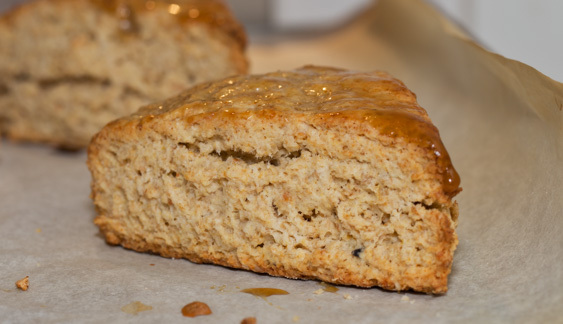Maple-Glazed Oat Scones

introduction
Pat-a-cake—the method, not the nursery rhyme—is ancient and Celtic, and Celtic hand foods unify much of the staple food culture of Western Europe. Long before high tea rushed scones onto the table and into high fashion, rural Celts across Europe and the British Isles fire-threshed hull oats to make simple porridge. They molded the leftover porridge pat-a-cake style and baked it into a crude round bread. In colonial Charleston, Huguenot oat flour, combined with elite hand-bolted wheat flours were used to make rustic risen scones. Those rustic scones could be considered an inspiration for our scone recipe here. Our toasted oats enter the formula, too, after soaking overnight in milk (the milk is then used to moisten the dough). These scones deliver uncommon oat scone character with singing nuttiness, caramel oat sweetness, and deep mineral fragrance and flavor in the snappy crust and the moist, textured interior.
Baking Notes
Soak the oats overnight in milk to soften them. The oats are already toasted and throw delicious round flavors into the milk—and subsequently the dough.
equipment mise en place
For this recipe, you will need a digital kitchen scale, a 2-cup liquid measuring cup (or a similarly sized bowl), a baking sheet, parchment paper, a fine-mesh strainer, a 1-cup liquid measuring cup (or a small bowl), a large mixing bowl, a metal bench scraper, a rolling pin, a wire rack, a small saucepan, and a pastry brush.
-
-
8ounces (1 cup) whole milk
-
1.75ounces (⅓ cup) Anson Mills Handmade Toasted Stone Cut Oats
-
10ounces (2 cups) Anson Mills Colonial Style Fine Cloth-Bolted Pastry Flour, plus additional for dusting the work surface
-
2ounces (½ cup) Anson Mills 18th Century Style Rustic Toasted Oat Flour
-
2tablespoons sugar
-
2teaspoons baking powder
-
½teaspoon fine sea salt
-
4ounces (8 tablespoons) European-style unsalted butter, cut into ½-inch cubes and kept cold
-
3ounces (¼ cup) dark amber or grade B maple syrup
-
Butter for serving
-
Jam for serving
-
-
The night before you plan to make the scones, measure the milk in a 2-cup liquid measuring cup (or similarly sized bowl). Add the oats and stir once. Cover and refrigerate until the morning.
-
Adjust the oven rack to the middle position and heat the oven to 425 degrees. Line a baking sheet with parchment paper.
-
Set a fine-mesh strainer over a 1-cup liquid measuring cup (or a small bowl). Pour the soaked oats and milk into the strainer and press the oats with a spoon to extract as much milk as possible (fig. 3.1). There will be between ¾ and ⅔ cup of strained milk. Set the oats and milk aside.
-
Turn the pastry and oat flours into a large mixing bowl. Add the sugar, baking powder, and salt, and toss with your fingertips until well combined. Scatter the cold butter pieces over. Rub the butter into the flour mixture with your fingertips (fig. 4.1), working quickly so the butter does not soften too much, until the pieces are the size of small pebbles. Turn the mixture out onto the counter. (Alternatively, if you are clumsy or hot-handed, you may prefer to use a food processor: Turn the dry ingredients into a food processor bowl. Pulse to combine, then scatter the cold butter pieces over the surface and pulse until the butter resembles coarse pebbles, about ten 1-second pulses. Turn the mixture out onto the counter.)
-
Sprinkle the drained, soaked oats onto the dry ingredients and mix quickly with your fingertips to distribute them evenly throughout (fig. 5.1). Using the bench knife, pull the entire mixture into a long, loose mound. Drizzle ⅓ cup of the strained milk evenly onto the mound (fig. 5.2), and, with your fingers, toss and fluff together the wet and dry ingredients. Repeat with another ⅓ cup of milk. Squeeze a couple of handfuls of the mixture together to test its moistness. If the dough holds together and feels uniformly moist, you probably don’t need more milk. If it feels dry-ish, toss in a bit more milk. Draw the ingredients together into a long mound with the bench knife. Use the heel of your hand and short, forward thrusts against the counter to flatten the butter and assimilate the ingredients (fig. 5.3). Scrape everything together with the bench knife and repeat the process so that the dough becomes a cohesive mass. Scrape everything together once again with the bench knife and press the dough into a rough round. Loosen the dough from the counter with the bench scraper, sprinkle the counter lightly with pastry flour, and replace the dough on the counter. Sprinkle the top of the dough lightly with flour. Bring any remaining bits of dough into the mass with the bench scraper and use a rolling pin to roll the dough into a 7-inch round about 1 inch thick (fig. 5.4). Cut the round into 8 even triangles. Arrange the scones on the prepared baking sheet (fig. 5.5) and bake until risen and edges are deeply browned, about 20 minutes, rotating the baking sheet halfway through.
-
While the scones are baking, in a small saucepan over medium heat, simmer the maple syrup until thick and reduced to about 2 tablespoons, about 5 minutes. Set the syrup aside until ready to use.
-
When the scones are ready, remove them from the oven and, using a pastry brush, immediately paint the tops with the hot syrup (fig. 7.1). (If necessary, rewarm the syrup before brushing.) Let the scones cool on the baking sheet on a wire rack for about 15 minutes. Serve warm, with butter and jam.
-
-
3.1

-
-
-
4.1

-
-
-
5.1

-
5.2

-
5.3

-
5.4

-
5.5

-
-
-
7.1

-